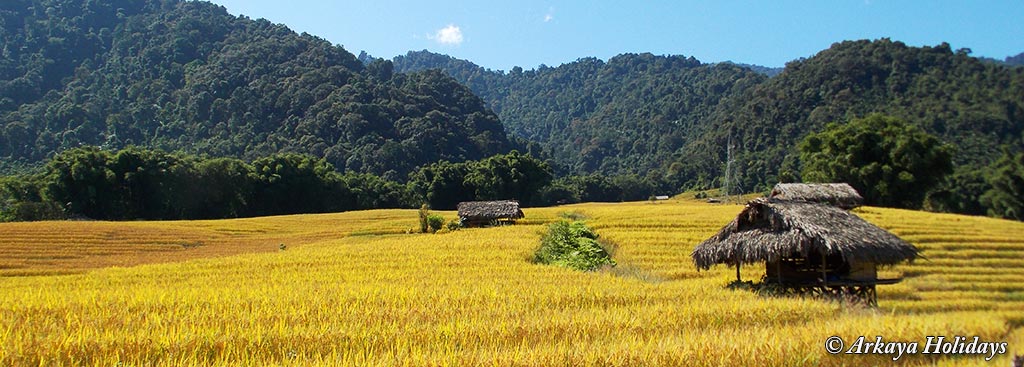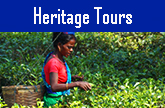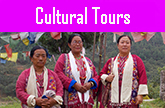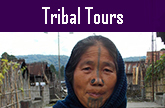Arunachal Pradesh Tourism
Arunachal Pradesh, the "land of the dawn lit mountains" is the largest state in the entire north-east surrounded by Assam and Nagaland in the south and has international borders with Bhutan in the west, China in the North and Burma (Myanmar) in the east. This land is a nature's treasure covered with mountain ranges and valleys. Earlier known as NEFA, Arunachal Pradesh attained the status of the 24th state of Indian Union on 20th February, 1987. It is a homeland to 25 major tribes and 110 sub-tribes which reflects its diverse ethnic culture. The main attractions of this state are Buddhist monasteries, spectacular natural sceneries, diverse tribal culture and the exclusive flora and fauna adding to the exotic natural beauty of the state.
Arunachal Pradesh: At A Glance
State Capital:
Itanagar
State Animal:
Mithun (Bos Frontails)
State Bird:
Hornbill
State Flower:
Rhynchostylis Retusa (Fox tail orchid)
State Tree:
Hollong
Number of Major Tribes:
25
Sex Ratio:
938 females for each 1000 males (Census Report of India, 2011)
Population Density:
17 per square kilometer
Geographical Location:
Longitude -- 91 ° 30' E to 97 ° 30' E & Latitude -- 26 ° 30' N to 29 ° 30 ' N
Area
Arunachal Pradesh covers an area of about 83743 sq km with 16 districts falling under it.
Population
Arunachal Pradesh has a population of about 1,382,611 out of which 720,232 are male and 662,379 are female. (Census Report of India, 2011)
Literacy
The literacy rate in Arunachal Pradesh is 66.95%. The male literacy rate is 73.69 % while female literacy is at 59.57 %. (Census Report of India, 2011)
Climate
The climate Arunachal Pradesh differs with elevation. Areas located at higher altitude have an alpine or tundra climate. Areas situated at a lesser elevation experience temperate climate. And areas located at the sub Himalayan and sea-level elevation enjoy humid, sub-tropical climate with hot summers and mild winters. Arunachal Pradesh receives heavy rainfall of 2,000 to 4,000 mm every year between May and September.
Economy
The economy of Assam is predominantly based on agriculture. The industries in Assam are based on the resources like agriculture, forest and minerals available in the state. Oil & natural gas, tea, paper, cement and petro chemical products are some of the major industries present in Assam.
History of Arunachal Pradesh
Ancient literature narrates legendary origins and tales of Arunachal Pradesh as 'Prabhu Mountain' meaning Lord Mountain. This 'hidden land' finds mention in the epic Kalika-Purana and in the great epics of Mahabharata and Ramayana. Arunachal Pradesh has been believed to be the famous land where sage Vyasa had meditated, Lord Parasurama discarded his sins, King Bhismaka established his kingdom and the place where shined the palace of Rukmini.
There is hardly any definite or reliable information regarding the history of Arunachal Pradesh. Its exact recorded history became available in the Ahom historical records of the 16th century. As maintained, these records states that the northwestern parts of Arunachal Pradesh were ruled by Monpa kingdom of Monyul during 500 B.C. and 600 A.D. These people were of Tibetan origin. Later, the northern areas came under the hold of Tibet and Bhutan, while the remaining areas shifted to Ahom rule until the possession of British in 1858 and amalgamated to mainland India.
During 1913-14 a treaty was negotiated by the representatives of China, Tibet and Britain to define the border line between Tibet and British dominated India. Subsequently, the British Administrator Sir Henry MacMohan drew up about 890 kilometers long MacMohan line as the border between British ruled India and outer Tibet in Shimla Conference. All the members almost came to the agreement of the treaty of MacMohan line, but the Chinese representatives refused to accept the agreement while the issue of the border of outer Tibet and inner Tibet arose as Tibet was not independent of China.
Later, NEFA (North East Frontier Agency) was formed in 1954 after India became an independent nation. The issue of border line erupted again during Sino-Indian War in 1962. The war resulted in termination of barter trade with Tibet. Nearly after two decades of the war, Arunachal Pradesh became a separate state in 1986.
Culture of Arunachal Pradesh
People
Arunachal Pradesh is a land of numerous tribes and communities. The people are divided into three cultural groups depending on socio-political and religious differences. The first group comprises of Monpas, Sherdukpens, Membas, Khambas, Khamtis and Singpho tribes. The second group is the Adis, Akas, Apatanis, Bangnis, Nishis, Mishmis, Mijis, Thongsa tribes. Noctes and Wancho tribes belong to the third group. Other sub-tribes include Idu, Miju or Kaman, Digaru or Taraon, Galos, Padams, Minyongs, Tagins, Khowas, Puroiks, Thongs, Gheos, Hill Miris, Sulung, Yabins and Zakrings etc. The societies are patriarchal-based and polygamy is socially practiced by most of the tribes. Each tribe possesses its own individual code of conduct, beliefs and faith.
Festivals
Festivals constitute a fundamental part of the socio-cultural life of the tribes of Arunachal Pradesh. Festivals are celebrated basing on various aspects such as to mark the beginning of the New Year, to seek Almighty’s grace for a good harvest, to demolish the evil forces and pray for happiness, success and hearty life, to be free and safe from natural destruction, epidemics and to reunite people. Some prominent festivals celebrated are Solung, Mopin, Losar, Boori Boot, Dree, Nechi Dau, Khan, Kshyat-Sowai, Loku, Longte Yullo, Mol, Nyokum, Ojiale, Reh, Sanken, Si-Donyi and Tamladu. Some other festivals such as Saka Dawa, Dukpa-Tse-Shi, Lhabab Duechen celebrate the holiness, the teachings and reincarnation of Gautam Buddha.
Buddha Mahotsava
Tawang in Arunachal Pradesh is recognized as one of the principal seats of Mahayana sect of Buddhism. Tawang Monastery is prominent as the second largest Buddhist monastery in the world after that in Lhasa. Buddha Mahotsava celebrated in Tawang is a major festival organized in collaborative teamwork by the Ministry of Culture & Tourism, Govt. of India and Department of tourism, Govt. of Arunachal Pradesh. The festival is rejoiced with much gaiety and enthusiasm to preserve unique Buddhist cultural heritage and promote religious tourism in the state. Buddha Mahotsava brings an exposure of noble Buddhist influence on the life of common people. This mega tourism event demonstrates the rich culture and traditions of the Monpa and other tribes of Mahayana sect. Exhibition and competitions of traditional dance forms of major tribes of Arunachal Pradesh like Monpa, Nyishi, Apatani, Adi, Aka, Mishmi, Sherdukpen etc. and other popular dances of India presented for three consecutive days adds grandeur to the majestic event. Other popular attractions of the festival include Buddhist Religious Functions, Fashion Show of Traditional Attire, Indigenous Games Show, Food Festival, Flower Show, Fire Works Show, Handloom and Handicraft exhibition, Film Festival, Photography Exhibition and Musical Concert of Bollywood Singers etc.
Torgya Festival
Torgya festival is a monastic festival observed in Tawang monastery for three days to chase off evil spirits & destructive forces and to protect the land against natural calamities so that people can lead happy, calm and prosperous lives. The festival occurs towards the end of January every year normally starting from 28th day of the eleventh month of lunar calendar. During the festival, some religious rituals (Torgya) of Yamactaka Chak Khar Zur Gurpa are performed and devotees around the state visit the Tawang monastery to celebrate the sacred event with joy and fervor.
Losar
Losar festival is the New Year celebration of the Monpa tribal community. The festival is observed for fifteen days in either January or February as per Monpa’s annual calendar. During Losar festival, Monpa people clean their residences; hoist colourful flags at the roofs, illuminate butter lamps in front of the altar at every household and visit the families of friends and relatives. They read Buddhist Holy Scriptures and offer prayers to the almighty seeking prosperity and fine health.
Nyokum
Nyishi tribal people celebrate Nyokym every year in the month of February worshipping the Goddess of Wealth along with other gods and goddesses. It is a two days’ agricultural festival rejoiced with much gaiety and devotion. First day, the priest starts the ritual by offering prayer to the images and symbols of gods and goddesses kept in an altar. Girls dance and sing with enthusiasm to please the unseen gods and goddess. They pray for plentiful crops, fine health and mutual co-operation among the people. Next day, being the final day of celebration, people of the neighbouring villages after performing all religious rites in their respective villages assemble together and take part in a parade. The animals to be sacrificed such as dogs, pigs and fowls are either carried in hands or hung in thick bamboo poles. On arrival at the main place of worship, the people move round the altar chanting prayers with sincerity and devotion. After the animals are sacrificed, the rituals of the festival come to conclusion.
Mopin
Mopin is the main festival of the Galo sub tribal community of Adi tribes. Mopin festival is celebrated for five days in the month of April with much gaiety and enthusiasm to drive away evil spirits, natural calamities and contagious diseases from earth as well as seeking God’s blessing for good harvest, fine health, more wealth and prosperity. The grand celebration of Mopin festival occurs prior to sowing of paddy. During this festival, Galo people perform the Popir dance by wearing traditional clothes with stylish headgears and multi-coloured ornaments. Unique blend of rhythmic steps of Popir dance with their folk songs create a magnificent atmosphere in this wonderful celebration.
Myoko
Myoko is a religious festival celebrated with much admiration and enthusiasm within the Apatani tribal community. The festival is rejoiced by almost all Apatani people desiring for general well being of the whole Apatani society. For absolute participation in the festival, the villages falling in the entire Apatani plateau are divided into three main groups – the first group consists of Hong village alone, the second group includes villages like Mudangtage, Bamin, Hija, Michi and Duta; and finally the third group consists of Regu, Hari, Kalang and Tajang. Each group organizes grand celebration of Myoko festival alternatively once in every three years and the other two groups take active part with the host group. The festival is observed every year in the month of March.
Apatani men prepare for the Myoko festival by hunting of bi-ding (monkey). The most important ritual of Myoko festival is the sacrifice of the pigs. However, the main attraction is the arrangement of erected poles with strong ropes made of cane utilized for a traditional acrobatics game performed by both men and women of all age groups.
Solung
Solung is the major agricultural festival of Adi tribal community. In the Solung festival, Adi people offer prayer in order to please 'Doying-Bote' (God of Heaven) and ‘Kine-Nane’ (Goddesses of Wealth & Prosperity) for their transformations into the forms of cloud and rain resulting in fertility of the soil. It is popularly believed that the successful union of both the divine seraphim will consequence in production of good harvest, more animals like Mithun (Bos Frontails), Pigs etc. and bring fortune, wealth and prosperity for all chasing off natural calamities, fire, accidents, diseases etc.
The celebration of Solung festival lasts for five days. The names of the five celebration days are 'Solung-Gidi Dogin' (the day of preparation), ‘Doreph-Long’ (the day of animal sacrifice), 'Binnayat Binam' (the day of worshipping), ‘Taktor or Ekoph’ (the day of preparation for making war weapons) and finally ‘Miri’ (the day of religious performance with songs and dances) consecutively. There is no fixed date for celebration of Solung festival. It is observed in the month of either August or September. Nowadays, the festival is rejoiced in a three day programme in certain places.
Dree
Dree festival is celebrated within the Apatani tribal community during the growing season of corps. In the Apatani language, the word 'Dree' means “a man who either borrows or purchases food grains from other people in order to curtail the scarcity by adding to his old stock of food grains.” During the celebration, a few rituals are carried out to worship divine Gods like Tamu, Metii, Danyi- Polo (the Sun and Moon) etc. collectively known as 'Dree Wuhi' (Gods) by offering sacrifices of mithuns, cows, pigs and fowls so that they will protect the crops and bless all to prosper in life. The festival is observed on 5th July every year.
Reh
Reh is the main festival of the Idu Mishmi tribe normally observed in the month of February. However, the Idu Mishmi people living in mountainous terrain of snow falling areas located in the Dibang valley celebrate the Reh festival in a temperate climate during summer season someday in the months from June to August. The Idu Mishmis commonly believe that they are fortunate successors of the Goddess 'Nanyi Inyitaya'. So in order to receive her blessings and maintain the intimate bond with her, they need to perform some essential religious rites in the Reh festival.
The items required for complete celebration of Reh festival are so expensive that common people cannot afford it. Sometimes people need to make all arrangements of the Reh festival from 3 to 5 years earlier than the actual commencing of the festival. A number of buffalos are required for sacrifice. Relatives are given various presents like pigs, fowls, money in cash etc. Reh festival is celebrated for 6 days.
Si-Donyi
Si-Donyi is the most important festival of the Tagin tribal people. It is celebrated in the month of January every year. Literally, ‘Si’ indicates the Earth and ‘Donyi’ signify the Sun. Tagins commonly believe that in their daily activities, the sun, moon, earth and other natural elements play a vital part. So in order to please these natural Gods, Tagins perform the festival of Si-Donyi.
The observation of Si-Donyi festival requires lots of money due to huge expenses involved in it. So people from all walks of society contribute according to their will in either kinds or cash. Si-Donyi is observed in collective teamwork of all age group of people. The Tagin youths work hard making arrangements following the advices of ‘Nibu’ (priest) elderly members of Si-Donyi committee. During the celebration, a paste is made of 'etting' (fine particles of rice) combined with ‘Apeng’ (rice-beer) which is considerably applied by everyone. Youths take active part in singing and dancing shows wearing colourful traditional dresses and split bamboo head gears (locally known as ‘Donger’).
Boor Boot
Celebrated in the first week of February, Boor Boot is the main festival of the Hill-Miris. In the local language “Boor Boot” literally means “to assemble together irrespective of any discrimination to welcome the spring for good crops”. During celebration, Hill Miris pray to the divine spirit of Boor Boot to protect them from diseases and bless them with prosperity. The festival is carried out in collective teamwork. Youths accomplish everything for arrangements following the guidance of elderly persons of the society. The priest performs essential rituals including sacrifice. The festival continues for three days.
Yulo
Yulo is a religious festival of the Nyishi tribal community. The religious rites are performed seeking the blessing of almighty for overall welfare of the society. The ritual is marked by sacrifice of 'mithuns'. The blood of animals’ sacrifices is collected by the priest in a bamboo tube who later hangs it in front of his house.
Saka Dawa
The festival of Saka Dawa is celebrated in the fourth month of lunar calendar rejoicing the achievement of Nirvana attained by Gautam Buddha.
Dukpa Tse-Shi
Observed in the 6th month of the lunar calendar, Dukpa Tse-Shi festival commemorates the preaching of the Four Noble Truths at Sarnath by Buddha.
Lhabab Duechen
Celebrated in the 9th month of Monpa’s annual calendar, Lhabab Duechen festival observes the reincarnation of Buddha in his Shakyamuni form.
Arunachal Pradesh: Places to Visit
 Bhalukpong Bhalukpong |
 Bomdila Bomdila |
 Dirang Dirang |
 Tawang Tawang |
 Itanagar Itanagar |
 Ziro Ziro |
 Daporijo Daporijo |
 Aalo Aalo |
 Mechuka Mechuka |
 Pasighat Pasighat |
 Roing Roing |
 Mayudiya Mayudiya |
 Tezu Tezu |
 Chongkham Chongkham |
 Eagle's Nest Eagle's Nest |
 Namdapha Namdapha |
North East India Tourism
Arunachal Tour Packages
At Arkaya Holidays, we present miscellaneous smart travel services to our valued guests across the earth who shares fervent passion for travelling. Our travel packages particularly designed for the promotion of Arunachal Tourism ensure happiness, safety and comfort in the “Land of the dawn lit mountains”. Travel smiling.
 Tawang Tour Tawang Tour |
 Arunachal Pradesh Tribal Tour Arunachal Pradesh Tribal Tour |


















